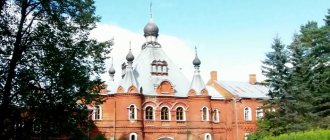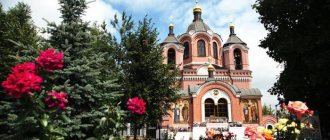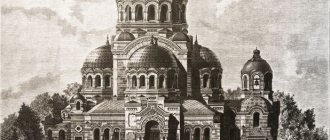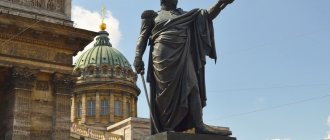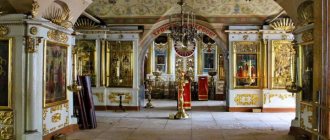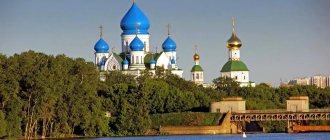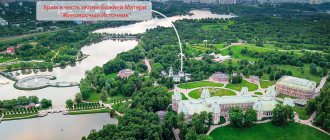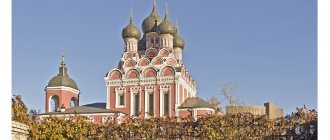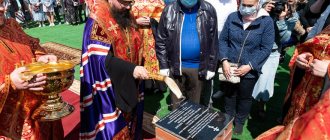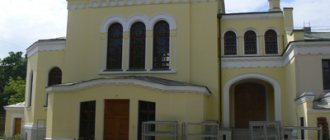Historical information
The Orthodox community of the western region of Moscow, led by Father Leonid, has been seeking for a long time that the capital authorities allocate a place for the construction of a church; the answer to their prayers came in 2003. With the blessing of His Holiness Patriarch Alexy II, a church community was founded in honor of the Icon of the Mother of God “Smolensk”.
Temple-chapel in the name of the Smolensk Icon of the Mother of God in Fili-Davydkovo
According to the “Program 200”, in 2013 a plot of land was allocated for the construction of a temple, and in 2014, as a memory of the 200th anniversary of the Battle of Borodino, a small church of the Smolensk Icon of the Virgin Mary grew here. This was a unique case when young people worked during the construction of the cathedral and its arrangement.
Rather, this diary is for those who are planning to visit St. Petersburg. This is a hint on how to get to the grave of St. Blessed Xenia at the Smolensk cemetery.
The first task is to figure out which of the St. Petersburg islands is called Vasilyevsky. This is the easiest thing on your upcoming route. Vaska is the largest island. The best guide for you will be the metro station of almost the same name - Vasileostrovskaya. So fix your gaze on it, because it will be easier this way. I have drawn with a red arrow one of the walking route options.
Approaching the Smolensk Orthodox Cemetery, on your right hand will be the beautiful, majestic Church of the Resurrection of Christ. Today, construction work is still underway there (possibly restoration, finishing, etc.). Further behind the entrance is the sky-blue Temple of the Smolensk Icon of the Mother of God. It is to him that I would like to pay more attention now, since many pilgrims run to Xenia’s grave, and not to the church where the blessed saint secretly carried bricks at night.
To this day, the dates of birth and death of Ksenia Grigorievna Petrova are unknown to contemporaries. It is only known that she became a widow at the age of 26, and her husband was a singer. I don’t think this is very important, but in some sources I read that he sang in a church choir, while others claim that he was a colonel in the choir of Empress Elizabeth I. This is more like the truth, because The Elizabethan choir was famous, and for participation in it the singers received moral and material rewards unimaginable at that time.
So, if it is known that the Smolensk Church, instead of a wooden one, became stone by decree of 1783, if by this time more than 20 years had passed since the death of Empress Elizabeth Petrovna, we can assume that Ksenia Petrova was about 50-60 years old at that time.
Not long ago, an oil portrait of her was discovered in the storerooms of the Hermitage. However, it is accompanied by a small, careful clarification: the portrait is SUBJECT.
This portrait was brought to the Hermitage from the Smolensk cemetery in 1930. Traces of wax and soot testified to his veneration by parishioners. A soil analysis showed that the painting was painted at the end of the 18th or early 19th century. Cleaning up later layers showed that the woman depicted originally had short gray hair, all of which supports the legend that Ksenia dressed in a man's suit and called people by the name of her deceased husband.
Let's return to the Smolensk Church. It was built by Archpriest Georgy Petrovich Petrov. Here he served for 42 years. And now I don’t know whether it’s an accident or whether there is some kind of relationship here - Ksenia was Petrova, and the priest was also Petrov. It is clear that there are countless Ivanovs-Petrovs-Sidorovs in Mother Russia, but... But for some reason it seems that this coincidence is not entirely accidental.
On the north side of the temple there is a memorial plaque with an epitaph. At the age of 84, Archpriest Georgy Petrov completed his earthly journey. His remains rest under the altar of the chapel of the Apostle and Evangelist John the Theologian.
Of course, the priest knew that the local holy fool went to the Smolensk cemetery, because it was impossible to hide this fact in those days. Why did Ksenia go here? The answer is obvious - her husband is buried here. Why else? Therefore, the rector of the Smolensk parish knew where Colonel Petrov’s grave was. It turns out that when Ksenia died, they buried her next to her husband. Of course, this is just an unconfirmed assumption, but, you see, it has the right to be.
People ask Blessed Xenia for different things. For example, last week a relative of mine asked for healing for her father. When I had problems with work a year and a half ago, I came here, and voila - my job today is great, a year and a half of absolute confidence in the future! They say that Ksenia’s intercession before the Lord helps in resolving family issues.
Once upon a time, legend says, a young girl asked Ksenia to help find her betrothed. “Go to the Smolensk cemetery, your husband is burying his wife there,” these were the words in response. Indeed, the girl went and met a widower there, with whom she later married and, as they say, lived happily ever after.
The rector of the Church of the Smolensk Icon of the Mother of God is Archpriest Viktor Aleksandrovich Moskovsky. One time was enough for me personally to feel that during his service you felt extraordinary grace and bliss. I don’t know what mechanisms influence the psyche and subconscious - either his voice, or something elusive and subtle - you feel your individual relationship with the world, huge and unknown to simple understanding, the world of believers, the world under the shadow of the Lord, preserved, protected and preserved by Him .
I have heard statements that here is the original Icon of the Smolensk Mother of God “Hodegetria” (“Guide”), but this is not so. In the Smolensk Church there is only a list of it. As far as believers know, there is no difference between the original and the copy, for both are just an image. It is the image that helps! And even more important is your faith!
The value of this list is that, according to legend, the original was created by the Evangelist Luke. Therefore, it makes sense for pilgrims to visit the Smolensk Church on Vasilyevsky Island. This image helps in protection from illnesses, from family troubles, protects from quarrels, conflicts, and especially in wars. At home with Nastya, “Hodegetria” (Kazan) stands next to the icon of Christ, and that’s probably why there is harmony, love and harmony in the family.
As far as I understood from reading, the image of the Smolensk icon is here most likely because the first to be buried in the Smolensk cemetery were the deceased representatives of the first builders of St. Petersburg - the workers of the Smolensk artel. The Smolenka River was then called Chernaya, and the island was not yet Vasilievsky (so named in honor of the ascetic of Peter I, Lieutenant Vasily Kormchin), but was Princely, and Menshikovsky, and Novopreobrazhensky, and simply Preobrazhensky... Emperor Peter in 1706 approved the future cemetery under a public pleasure garden, the layout of which was entrusted to Menshikov by the Tsar. After 12 years, Peter I wanted to look at the results, but what he saw was not at all what he expected. Of course, his friend stole the money and used the allocated land to build houses and for a cemetery.
First, 148 thousand workers were brought here from Smolensk. They brought it in, but they didn’t give me any tools. People dug canals and built the city with their bare hands. That is why they died due to hunger, scurvy and viral diseases. Then they brought in a new batch of hard workers - 40 thousand. The pestilence continued. That is why the statement is true that St. Petersburg stands on human bones. And only then did workers begin to be brought to the capital on a “shift” basis. Specifically, 15 thousand people come from Smolensk every year.
To this day, some argue that this is not the case. They say that all the first dead builders were buried near Sampsonievskaya Church. In this case, I apologize, if the first structure appeared there in 1710, then where were people buried since 1703? Or has no one died in seven years?
Why these clarifications? - you ask. But the fact is that during the years of Blessed Xenia’s life it was simply not allowed to bury anyone in the Smolensk cemetery. As far as we know, the Saint did not have money for burial. Therefore, Archpriest Petrov’s permission to bury her here was not without reason. As my assumption was made above, one of the motives was to place her next to her husband (which, I repeat, is not confirmed historically). A more compelling reason, rather, was the veneration of her by people. The question is, could the priest just take it and say, I don’t know anything, let’s act according to the instructions from above? I could! However, Ksenia was buried here. However, someone could have financed her burial, but this once again proves that Ksenyushka the Wanderer had good fame. By the way, it is not difficult to notice that the chapel over her grave is not so far from the Smolensk Church. According to the decrees of the Synod of those years, not everyone was allocated land for burials near churches!
At that time, there were two chapels in the Smolensk Church: the Archangel Michael and the Smolensk Icon. The Church of St. Michael the Archangel was called. He was poor, but necessary. Funeral services were held here for the poor. There were a lot of children who died from smallpox. That is why this church was also called “smallpox”. Nobody allocated money for the construction of the church. Father Petrov had to go through so much - he appealed to the rich people with requests for help, because funds were needed both for materials and to feed the workers. This is where his attitude towards Ksenyushka, who brought in pennies for the future temple, becomes clear. Therefore, one should look at the current temple as the fruit of her life - it contains both her pennies and bricks, so scarce for that time.
Someone in the Life of Blessed Xenia sees her fidelity to her husband, calling her fate an example of true love. Someone honors the saint’s foresight, her gift of predicting destinies in the “Aesopian” language of holy fools. Someone notes that she gave herself into the power of God, and for this love she was so rewarded that to this day she is able to share her gifts with anyone who turns to her with a request. It depends on everyone, but I see her holiness precisely in the fact that she helped the Bride of Christ - our Orthodox Church. Here, take a closer look! Ksenia stands against the backdrop of the temple that this diary is about.
Therefore, each of us can please God by helping the Church. When I hear that someone has God in their soul, I just want to answer: but God wants to have a wider space, why are you locking it in yourself, why are you usurping it? Do you understand that God is not for you, but you are for God! Can you feel the difference?
Yes, Archpriest Petrov did the almost impossible for the Smolensk Church - he raised and provided for it. However, in the memories he remained a despotic and proud priest. And in his notes there was preserved a quote from the Apostle Paul, handwritten by him: “He who labors, let him eat, and he who labors not, let him not eat.” He himself, on the days when he could not find a penny for the construction of the temple, fasted. And his subordination was not so exemplary - the sextons and choristers, other ministers - were from among those who were sent to the cemetery because of incivility in other places. However, this is a completely different story, the details of which would be better left outside our ABC. If anyone is interested, here is a link to the reprint (read as an e-book): link
Presumably calculating the years of Blessed Xenia’s life, researchers became convinced that she died no later than 1806. That is, before the Patriotic War of 1812, before the terrible flood of 1824. And here there is some significant detail. Here's the thing. Today, not far from her chapel stands the Chapel of the Holy Trinity.
A plaque on the chapel states that the temple was consecrated in 1831. I found sources that claim that before the construction of a stone church on this site, there stood the aforementioned wooden church of the Archangel Michael, dismantled after the flood of 1824. Therefore, Blessed Xenia was buried near him. This means that she was revered during her lifetime even more than it initially seemed to me! This also means that her grave after the flood was not so difficult to find, but some atheist skeptics are still shouting that she is not there! There!
The flood was terrible. Above the Smolensk cemetery, the water rose 10 feet, that is, more than 3 meters. November. Cold. Storm waves. The grave mounds were washed away. Trees were uprooted. The crosses were carried away from the tombstones in such a way that they then drowned a naval hospital on the Vyborg side for three months. Three old women drowned in the basement of a cemetery almshouse. I do not at all rule out that Blessed Xenia could sometimes find shelter in this almshouse, although there are allegations that she wandered around the neighboring island - on the Petrograd side, not far from the Church of St. Matthew the Apostle, destroyed by the godless Soviet regime. The only reminder left is the Matveevsky Garden, and even then it was returned in place of the Kalininsky (ugh!) Garden. Link
That is why the years of life of both Ksenia Grigorievna and her husband Andrei Fedorovich are unknown, because the documents (church records) were destroyed by the floods of 1777 and 1824.
*
Smolensk cemetery on Vasilyevsky Island. There on the Strelka there is the symbol of St. Petersburg - the Rostral Columns. In the picture you can see how much the water rose then.
So, when the Church of the Holy Life-Giving Trinity was being built, a chapel was erected at the same time over the grave of Xenia - in 1830, that is, after a terrible flood. This is another proof that people had confidence in her holiness immediately after completing her earthly journey. The chapel we see today was built in 1902.
When the Bolsheviks came to power, the chapel was closed. But she did not stand for long, protected by oblivion and silence. In 1957, a shoemaker's workshop was opened in the chapel. The singer of the Smolensk Church, Marfa, recalls: “Xenia’s grave was walled up, and it was on this spot that the shoemakers worked. But the Lord is not scolded: Christ’s Pleasant did not allow them to drive in a single nail—everything fell out of their hands.” Then they decided to start casting plaster statues here. But nothing came of this either. It used to be that the masters would lock the chapel tightly, and in the morning... instead of sculptures, there would be rubble lying around. Finally, in 1983, the chapel was returned to the believers, and after restoration in 1987, it was consecrated by Metropolitan Alexy of Leningrad and Novgorod, the future Patriarch Alexy II.
By the middle of the 19th century, the Smolensk cemetery was the largest in the city. Over the entire pre-revolutionary period of the cemetery’s existence, the number of buried people reached approximately 700-800 thousand. And then more and more - the siege survivors were also buried here. Can you imagine? So you came to this cemetery, and here there are a MILLION!
A year after the revolution, the Smolensk Church was deprived of all funds, and all metric books and documents on burials before 1918 were confiscated. The Church of the Resurrection, at the entrance to the cemetery, was closed and in 1930 converted into a dormitory. And the stone Trinity Church was completely demolished in 1932. Only the Smolensk Church has survived - no wonder Ksenia helped build it!
In 1920, the Smolensk Church was given to the renovationists. This is not good, of course, but this is what made it possible to preserve the temple, which was closed in 1940 and returned in 1946. And this was the only church operating at that time on Vasilyevsky Island.
Smolensk Cemetery is a difficult place. Here, for example, is the first grave of Alexander Blok. Yes, the same one who crucified Jesus Christ for the second time in his poems, but who managed to regret it to death, having become disillusioned with the ideals of the revolution. He renounced his poem “The Twelve,” but it was too late. This is fate: “Sing the revolution, and it will kill you!” Blok died of hunger. How I would like to show this example to many rebels and revolutionaries, but it’s a pity that those who will find it useful will not read this diary. By the way, it is stated that Blok’s body remained here, and only his skull was transferred to the Literary Bridge of the Volkovsky Cemetery. Link
And here is an inconspicuous grave, under the tombstone of which lie 40 martyrs, buried alive here by the Soviet regime for not renouncing the Orthodox faith. For several days their groans were heard from underground, until finally a ray of sun fell on the grave mound. And only then did the sounds from underground stop. Every time I remember such atrocities, I constantly ask: “Well, who else here wants to return to the bright times of the USSR?”
Here at the Smolensk cemetery are the graves of Blessed Anna, Blessed Irina (alas, I couldn’t find out anything about her), Blessed Grigory Monetka...
Having graduated from one of the St. Petersburg institutes, Anna was preparing for marriage, but her fiancé chose someone else. Then Anna left St. Petersburg and began to wander. Once she was placed in an almshouse at the Bolsheokhtinsky cemetery, but Anna soon left there too. Dressed in miserable rags, with a stick and a huge begging bag on her back, Anna wandered the streets of the city, having no permanent place of residence. Almost every day I came to the Spaso-Sennovsky Church on Sennaya Square. The inhabitants of Sennaya - traders, clerks, laborers, cab drivers - knew her well and willingly gave her alms. Anna distributed all the alms she received to the poor.
Gregory was born into a wealthy family and studied at the seminary. One day he had an insight: “God takes care of me, gives me what I need, and I don’t need anything else.” He gave away his wealth. I went on foot to Jerusalem and spent 2 years on the road. People helped him, gave him food, drink, shelter. Returning to St. Petersburg, he went to see his friend, with whom he studied at the seminary. He was already a priest. A friend gave him a gold coin worth 5 rubles. Returning from him, Gregory saw a man on the bridge about to jump down. He spoke to the poor fellow. He told Gregory that he had lost everything at cards, and he had 6 children. Gregory gave the man a gold coin. He was very grateful for the help and promised to repay the debt as soon as he improved his affairs. And this day came, the man became rich. When he came to repay the debt to his savior, he did not take the money, but ordered it to be given to those who really needed it. Thus, with the light hand of Grigory Monetka, a “financial pyramid” was founded, which, unlike the existing ones, thanks to human mercy, will never collapse. From then on it went like this, the money was passed from hand to hand, from wealthy people to the needy, and helped the latter improve their affairs so that they, in turn, could also help the needy. Gregory lived to a ripe old age, but even after his death he continued to help people.
There is a popular belief that if you put money on his grave, then things will quickly go uphill. The money will go to someone who needs it at the moment and will also provide assistance. In the future, this person, having improved his financial situation, will also come to the grave to share his wealth with people in need. Having increased your wealth in this way or improved your financial situation, you must definitely come to the grave of Grigory Monetka and thank him for his help.
The holy martyr Maria of Gatchina was also buried near Blessed Xenia. Now her relics have been transferred. More details here: link + link Eduard Khil is buried nearby, and literally three months ago, a few steps from Blessed Xenia, according to her will, Lyudmila Senchina was buried. Link + link
Nanny A.S. is buried at the Smolensk cemetery. Pushkin - Arina Rodionovna Yakovleva. It seems that this is the honor the serf woman deserves! People go and go to her grave, but that’s not a fact! The fact is that it is unknown today where her grave is! The “drinking companion” and teacher of the great Russian poet played a necessary role in her time and remained “behind the scenes.” Pushkin saw her a year before her death, did not go to the funeral, and when he remembered that it would be nice to visit her grave, he no longer found the grave. And it was not the fault of the flood of 1824, which had already been raging for three years, but other factors. Yes, and I remembered while walking, when a tipsy man with friends was staggering among other people’s graves. The glorification of the burial place of Pushkin’s “friend of harsh days” took place in 1977. Hmmm, it’s a pity, of course! Grandma deserves respect.
And here’s some more useful information for you, pilgrims:
The Divine Liturgy in the church in the name of the Smolensk Icon of the Mother of God is celebrated daily at 10.00.
On holidays and Sundays, two liturgies are celebrated - an early one at 7.00 and a late one at 10.00.
Every day at the end of the liturgy - the Sacrament of Baptism.
Evening services begin at 18:00 in the summer and at 17:00 in the winter.
Prayers for health and memorial services for the deceased in the chapel of Blessed Xenia are served daily from 11.00 on weekdays and from 10.00 on holidays.
The chapel is open to visitors until 17.00.
Address of the Church of the Smolensk Icon of the Mother of God, to which you can send letters and postal orders with notes for prayer services and memorial services:
199048, St. Petersburg, Vasilyevsky Island, Kamskaya st. 24, rector Archpriest Victor of Moscow.
Description of the architecture
The style of the Church of the Virgin Mary is characteristic of Russian buildings of the 19th century. Russian architecture is based on the canons of Russian architecture, an example of which is the Intercession Cathedral of the Mother of God on the Moat.
Interior of the Church of the Smolensk Icon of the Mother of God
Suzdal Orthodox shrines were always erected on a hill so that they could be seen from everywhere. Using the same principle, a church was built in honor of the Smolensk image of the Virgin Mary in Davydkovo.
Novodevichy Convent during the USSR
The activities of the Novodevichy Convent were disrupted with the advent of Soviet power. His charitable and educational projects were closed, his money was confiscated, and his land and buildings were handed over to the Red Army and workers. The monastery was abolished in 1922, and about 700 people settled on its territory. In 1934, a branch of the State Historical Museum was created here - a museum of the era of Princess Sophia and the Streltsy riots, where former nuns worked as restorers, janitors and watchmen. At the turn of the 20th century, there were about 3,000 tombs in the Novodevichy Necropolis, where prominent figures of the tsarist era rested. After the destruction of Moscow necropolises in the 1930s, less than a hundred graves remained.
This is interesting: Religious activities in the Novodevichy Convent resumed in 1944. He continued to play an important role in the religious life of Moscow during the remaining Soviet years.
Temple social work
Social activities in the area are supervised by the rector of the Church of the Smolensk Icon of the Mother of God.
The Moscow Children's Infectious Diseases Hospital is under the care of parishioners; they collect donations to purchase medicines and hygiene products for children. The rector of the temple and the priests conduct the rite of Baptism of infants once a month right in the hospital.
Important! Under the spiritual guardianship of the social service center are film veterans, soldiers of military units, and employees of orphanages. Parishioners support convicts in correctional colonies with spiritual literature.
Elderly and infirm people have found shelter here, where they will be clothed and fed. Sunday school offers classes for both children and adults. From 11.00 am until evening. 19.00 everyone can visit the church library.
Novodevichy Convent today
The Novodevichy Convent is listed as operating since 1994, and in 2011 the Russian government transferred it to the Moscow diocese. The decision to convert the monastery into a museum during Soviet times, combined with exceptional restoration work carried out at the end of the 20th century, meant that much of the ensemble survives to this day. The Novodevichy Convent was recognized by UNESCO as a World Heritage Site in 2004. Today it is one of the most popular attractions in Moscow.
This is interesting: The first abbess of the monastery in the post-Soviet period was Abbess Seraphim. Previously, she was a professor of technical sciences and was awarded the USSR State Prize for her work on the development of materials for space suits and latex technology. Despite living her entire life under Soviet rule, she never gave up her faith and became abbess after her retirement.
There are about 10 churches and chapels in the Novodevichy Convent, some of which are made in the White Stone Byzantine style of Kievan Rus. Others are in the magnificent Moscow Baroque style, decorated with frescoes and complex iconostases.
As a monastery for royal and noble women seeking monastic vows, the design of the Novodevichy Convent reflects its elite character. It is famous for its harmonious Moscow Baroque architecture, one of the most complete embodiments of this style in modern Russia. The monastery is surrounded by an almost kilometer-long fence of jagged white stone walls up to 11 meters high and up to 5 meters thick. They are interspersed with 12 fortified towers, and enclose residential buildings, former imperial chambers, a number of beautiful churches, as well as the Novodevichy Necropolis and cemetery.
Churches of the Novodevichy Convent
Smolensky Cathedral
The main temple of the ensemble. The oldest and largest stone building, topped with four silver domes and one central golden dome. Its interior is decorated with rare frescoes of the 16th-17th centuries and a magnificent five-tiered gilded iconostasis with icons donated by Russian tsars. The cathedral contains the tombs of Peter the Great's wife Evdokia and his sisters Catherine, Evdokia and Sophia.
Church of the Assumption of the Blessed Virgin Mary
This church is notable for its architectural beauty, with white window frames, cornices and columns contrasting with the dark red brick. The interior is a large atmospheric hall, no different from a ballroom, with wide windows, a vaulted ceiling, chandeliers, gold-framed icons along each wall and an 18th-century iconostasis.
Church of the Intercession of the Blessed Virgin Mary
Situated at the southwest gate of the monastery, this church is topped by two-tiered side towers and a large central tower with a golden dome. This is typical for Ukrainian religious architecture. The church was used as the home chapel of Princess Maria, half-sister of Peter the Great.
Church of the Transfiguration
The impressive church, built in 1689, dominates the north gate of the monastery. Its architecture is incredibly harmonious: high walls are framed by rows of windows in white frames, topped with white stone carvings in the form of shells, four small towers and one central one, each of which has a golden dome. The huge multi-tiered iconostasis was created by icon painter Karp Zolotarev and has survived to this day. Adjacent to the church are the Lopukhin Chambers, the residence of Peter the Great's first wife Evdokia.
Church of St. Ambrose of Milan
This small white church is the second oldest architectural monument of the monastery ensemble. It adjoins the chambers of Irina Godunova, sister of Tsar Boris Godunov.
Prokhorov Chapel
A tiny chapel erected over the grave of the famous Prokhorov family. The chapel was designed in a neo-Russian architectural style, framed by elegant metalwork, layers of semicircular kokoshniks and crowned with a large golden dome.
origin of name
There are several versions about the origin of the name of the monastery. According to one of them, the field on which it is located is called “girls’” because from here Russian girls were taken into captivity in the Golden Horde as a tribute to the Tatar khans. Other historians believe that the name was given in honor of Abbess Elena Devochkina, who was the first abbess. It is believed that the monastery in Khamovniki was called Novodevichya to avoid confusion, since there was also a Starodevichya in the Moscow Kremlin (destroyed in the second half of 1929).
Museum of the Novodevichy Monastery
The Novodevichy Convent hosts various historical and art exhibitions.
Life of Mother Superior Seraphima
An exhibition dedicated to the first abbess of the Novodevichy Convent in the post-Soviet period, Varvara Vasilyevna Chernaya. Visitors can see archival photographs of the life of Mother Superior Seraphima, personal belongings and family heirlooms, church and state awards.
Russia and the Novodevichy Convent in 1812
This exhibition explains how the monastery survived Napoleon's invasion of Moscow and provides general information about the battles that took place during the War of 1812. There you will see uniforms, artifacts of the Battle of Borodino, fragments of destroyed churches, portraits of historical, military and religious figures.
Collection of icons of the Blessed Virgin Mary
An exhibition of the entire collection of Novodevichy icons of the Blessed Virgin Mary, numbering more than 80 icons of different styles and periods, including some of the most revered icons of Russia.
Moscow diocese yesterday and today
This exhibition shows how Moscow churches were restored from ruins in the post-Soviet era. It showcases the historical, cultural and religious heritage of Moscow from the Stalinist period to the present day with a collection of photographs and videos.
"Fiery Tongues of Grace"
This exhibition, housed in various buildings of the monastery complex, includes icons from the early 1700s of the Russian and Western schools of painting, wooden religious sculpture and important architectural features of the monastery ensemble.
Novodevichy Necropolis and cemetery
The Novodevichy Necropolis was founded in the 16th century as the resting place of the most honorable statesmen of Russia: scientists, writers, representatives of the nobility and the royal family. In 1898, a new cemetery was built outside the monastery walls to bury prominent intellectuals, political and military figures. In the 1940s it was expanded as a burial place for important Soviet figures and became the most famous cemetery in the Soviet Union.
As a result of the desecration of the Novodevichy Necropolis in the 1930s, less than a hundred graves remained, including the Decembrists Sergei Trubetskoy and Mikhail Orlov, as well as the hero Denis Davydov. However, the Novodevichy cemetery, which extends beyond the walls of the monastery, contains more than 27,000 graves. Among the most famous inhabitants of the cemetery are writers Nikolai Gogol, Anton Chekhov and Mikhail Bulgakov. Also opera singer Fyodor Chaliapin, composer Dmitry Shostakovich, theater director Konstantin Stanislavsky, film director Sergei Eisenstein, founder of the Tretyakov Gallery Pavel Tretyakov, chief investigator of the Chernobyl disaster Valery Legasov, Stalin's wife Nadezhda Alliluyeva-Stalina, presidents Nikita Khrushchev and Boris Yeltsin.
Where is it and how to get there
Address: Novodevichy proezd, 1, Moscow. RF.
Directions to the station metro station “Sportivnaya” (red line). Then walk 5 - 7 minutes. Exit towards the Luzhniki stadium.
You can use ground transport: bus 64, 132 or trolleybus routes 5 and 15.
A place sacred to any Russian has been transferred for free use to the Moscow Patriarchate. Not only believers come here for prayers, but also tourists who admire the beautiful architecture of historical monuments. The complex is open to everyone, both for independent inspection and for an interesting excursion.
Bell tower of the Novodevichy Monastery
Built in the last year of Princess Sophia's regency, the bell tower is considered one of the most beautiful and impressive in Moscow, and has no analogues in Russian religious architecture. The 72-meter tower consists of six octagonal tiers decorated with white balustrades. The third and fifth tiers contain bells, and the lower two tiers are occupied by churches. Due to its enormous height, the bell tower is visible for many kilometers around.
This is interesting: The outstanding Soviet architect and artist Vladimir Tatlin set up a workshop in a non-existent bell tower in the 1920-1930s. Here he developed his famous Letatlin glider, which, unfortunately, did not take off.
Opening hours and visiting procedures
The complex is open from 08:00 to 20:00, on Sunday from 06:30 to 20:00.
Opening hours:
- in winter from 10:00 to 17:15, the ticket office is open until 16:45
- in summer from 10:00 to 17:30
Closed: Tuesdays and first Monday.
Cost of entrance tickets to the territory of the “Church Museum of the Moscow Diocese of the Russian Orthodox Church”:
- adults – 300 rubles;
- Children, pensioners and students admission – 100 rubles.
- Photo – 100 rubles
- Video shooting – 300 rubles
Excursion, duration – 2.5 hours.
- Adult ticket – 500 rubles
- Child – 300 rubles
